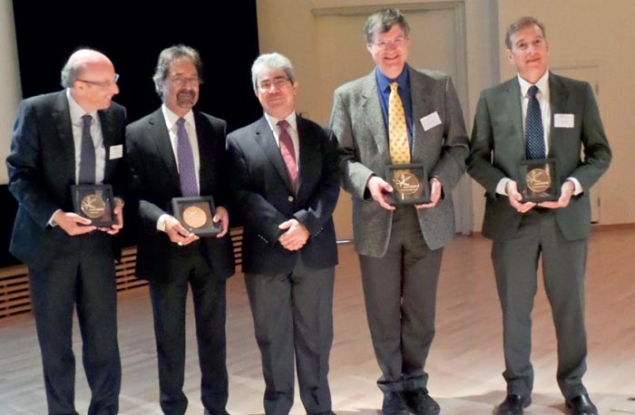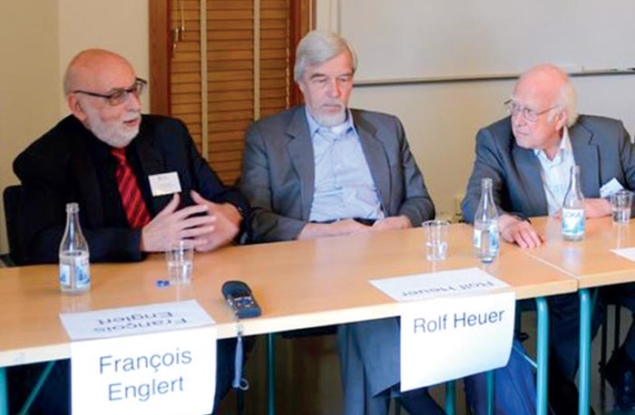Stockholm, with its many stretches of water, islands and old town, provided an attractive setting for the 2013 International Europhysics Conference on High-Energy Physics, EPS-HEP2013 on 18–24 July. Hosted by the KTH (Royal Institute of Technology) and Stockholm University, the conference centres on a busy programme of parallel and plenary sessions.
Like particle physics itself, EPS-HEP has a global reach, with people attending from Asia and the Americas, as well as from Europe. This year there were some 750 participants, including many young people who presented results in both parallel and poster sessions. As many as 440 speakers and more than 100 presenters of posters brought news from a host of experiments around the world, ranging from those at particle accelerators and colliders to others deep underground and in space.

Image credit: Abha Eli Phoboo.
Coming just one year after the announcement of the discovery of a new boson at CERN’s LHC, the conference provided a showcase for the latest results from the ATLAS and CMS experiments, as well as from Fermilab’s Tevatron. Together, they confirm the new particle as a Higgs boson, compatible with the Standard Model, and are making progress in pinning down its properties. Other measurements from the LHC and the Tevatron continue to test the Standard Model, as in the search for rare decay modes. The CMS and LHCb collaborations presented results on the decay Bs → μμ, two years after the CDF collaboration reported a first measurement, in slight tension with the Standard Model, at EPS-HEP2011 in Grenoble. CMS and LHCb now observe this decay at more than 4σ, with a branching fraction that is in good agreement with the Standard Model, therefore closing a potential window on new physics (Strangely beautiful dimuons).
All four of the large LHC collaborations – ALICE, ATLAS, CMS and LHCb – presented results in the dedicated sessions on ultrarelativistic heavy ions, which also featured presentions of measurements from the Relativistic Heavy-Ion Collider at Brookhaven. First results from the proton–lead run at the LHC are yielding surprises, including some intriguing similarities with findings in lead–lead collisions (Charmless baryonic B decays).

Image credit: Terry Pritchard.
Beyond the Standard Model, the worldwide search for dark matter has progressed with experiments that are becoming increasingly precise, gaining a factor of 10 in sensitivity every two years. There are also improved results from experiments at the intensity frontier, in the study of neutrinos and in particle astrophysics. Highlights here included the T2K collaboration’s updated measurement with improved background rejection, which now indicates electron-neutrino appearance at a significance of 7σ (T2K observes νμ→νe definitively). Other news included results from the GERDA experiment, which sets a new lower limit on the half-life for neutrinoless double-beta decay of 2.1 × 1025 years.
Other sessions looked to the continuing health of the field, with presentations of studies on novel ideas for future particle accelerators and detection techniques. These topics also featured in the special session for the European Committee for Future Accelerators, which looked at future developments in the context of the update of the European Strategy for Particle Physics.
An important highlight of the conference was the awarding of the European Physical Society High Energy and Particle Physics Prize to the ATLAS and CMS collaborations “for the discovery of a Higgs boson, as predicted by the Brout-Englert-Higgs mechanism”, and to Michel Della Negra, Peter Jenni and Tejinder Virdee, “for their pioneering and outstanding leadership roles in the making of the ATLAS and CMS experiments”. François Englert and Peter Higgs were there in person to present the prizes and to take part in a press conference together with the prizewinners. Spokespersons Dave Charlton and Joe Incandela accepted the prizes on behalf of ATLAS and CMS, respectively.
Wrapping up the conference in a summary talk, Sergio Bertolucci, CERN’s director for research and computing, noted that it had brought together many beautiful experimental results for comparison with precise theoretical predictions. “These are lucky times for physics,” he concluded, with experiments and theory providing an “unprecedented convergence of the extremes of scales around a common set of questions”.
• For details on all the talks see http://eps-hep2013.eu. A longer report will appear in a future edition of the CERN Courier.





